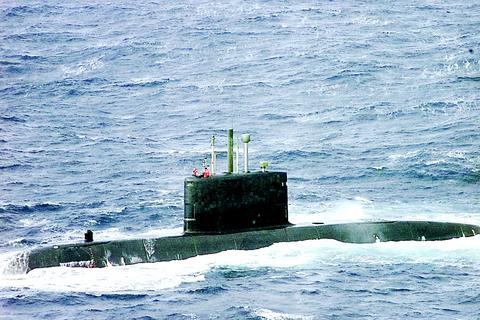A sailor injured in a fire that disabled a Canadian submarine died Wednesday of his injuries, Britain's Ministry of Defense and Canadian Prime Minister Paul Martin said.
The diesel-powered submarine drifted in the Atlantic as British ships battled through rough weather to reach it and the 54 crew members who remained on board.

PHOTO: EPA
Britain's military airlifted Lieutenant Chris Saunders and two other injured sailors from the vessel earlier Wednesday. Martin said Saunders had died during the airlift but provided no further details.
"He gave his life serving his country and we owe his family our deepest condolences," Martin told Canada's House of Commons in Ottawa. "We pay him homage and we make known our deep respect to his family."
Rescuers had intended to take the three injured men to a hospital in Londonderry, Northern Ireland, but had to divert on short notice to Sligo, in the Republic of Ireland, because Saunders' condition deteriorated and he needed immediate treatment.
Officials had initially described the Tuesday electrical fire aboard the HMCS Chicoutimi as small.
But Commodore Tyrone Pile, commander of the Canadian Atlantic Fleet, said Wednesday it was "a major fire" that was worse than first thought.
Lawmakers in Ottawa observed a moment of silence in honor of Saunders, a father of two.
There was no immediate word on the condition of the two other crew members brought to Sligo for treatment, but the hospital said they were able to walk. Canadian officials said a total of nine people had suffered smoke inhalation from the blaze.
The six others did not require hospitalization and remained aboard the submarine, adrift about 185km northwest of Ireland. No injuries were reported among the remaining members of a crew that originally numbered 57.
The Chicoutimi was only four days into its maiden voyage as a Canadian vessel when it sent out a distress call Tuesday.
Three British naval vessels and two tug boats planned to tow the sub to a Scottish naval base, but a Canadian naval officer said rough seas might force any attempt get a tow line to the vessel until today.
The lead rescue ship, frigate HMS Montrose, reached the Chicoutimi at about 1pm on Wednesday, and pulled alongside to drop off medical staff and supplies and assess the damage, the Ministry of Defense said in London.
"They've got emergency lighting on board. It is probably going to get a little bit cold, but they have sufficient blankets and other means to keep warm on board the submarine," Pile said. "It's going to be uncomfortable with the movement of the sea."
An Irish naval vessel, LE Roisin, tried to reach the sub Wednesday but turned back after being damaged in heavy seas, the Irish Defense Forces said.
Another British ship laden with food and fuel and carrying a medical team and helicopter was also on the way.

A fire caused by a burst gas pipe yesterday spread to several homes and sent a fireball soaring into the sky outside Malaysia’s largest city, injuring more than 100 people. The towering inferno near a gas station in Putra Heights outside Kuala Lumpur was visible for kilometers and lasted for several hours. It happened during a public holiday as Muslims, who are the majority in Malaysia, celebrate the second day of Eid al-Fitr. National oil company Petronas said the fire started at one of its gas pipelines at 8:10am and the affected pipeline was later isolated. Disaster management officials said shutting the

US Vice President J.D. Vance on Friday accused Denmark of not having done enough to protect Greenland, when he visited the strategically placed and resource-rich Danish territory coveted by US President Donald Trump. Vance made his comment during a trip to the Pituffik Space Base in northwestern Greenland, a visit viewed by Copenhagen and Nuuk as a provocation. “Our message to Denmark is very simple: You have not done a good job by the people of Greenland,” Vance told a news conference. “You have under-invested in the people of Greenland, and you have under-invested in the security architecture of this

Japan unveiled a plan on Thursday to evacuate around 120,000 residents and tourists from its southern islets near Taiwan within six days in the event of an “emergency”. The plan was put together as “the security situation surrounding our nation grows severe” and with an “emergency” in mind, the government’s crisis management office said. Exactly what that emergency might be was left unspecified in the plan but it envisages the evacuation of around 120,000 people in five Japanese islets close to Taiwan. China claims Taiwan as part of its territory and has stepped up military pressure in recent years, including

UNREST: The authorities in Turkey arrested 13 Turkish journalists in five days, deported a BBC correspondent and on Thursday arrested a reporter from Sweden Waving flags and chanting slogans, many hundreds of thousands of anti-government demonstrators on Saturday rallied in Istanbul, Turkey, in defence of democracy after the arrest of Istanbul Mayor Ekrem Imamoglu which sparked Turkey’s worst street unrest in more than a decade. Under a cloudless blue sky, vast crowds gathered in Maltepe on the Asian side of Turkey’s biggest city on the eve of the Eid al-Fitr celebration which started yesterday, marking the end of Ramadan. Ozgur Ozel, chairman of the main opposition Republican People’s Party (CHP), which organized the rally, said there were 2.2 million people in the crowd, but